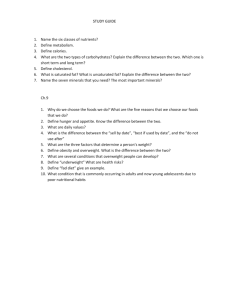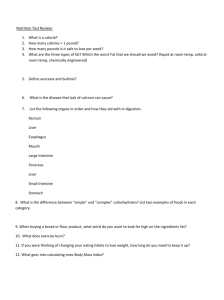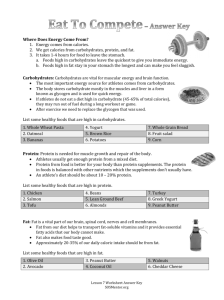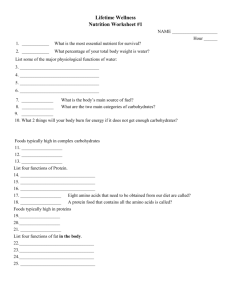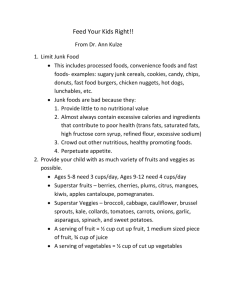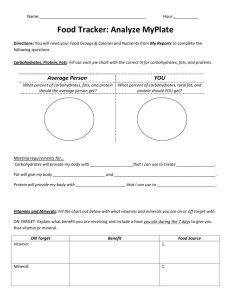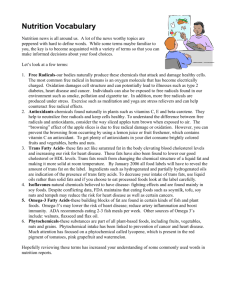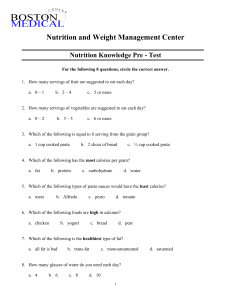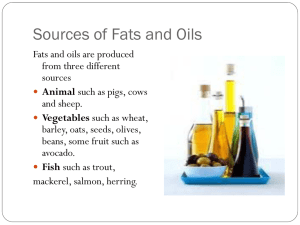a new year means a new you
advertisement
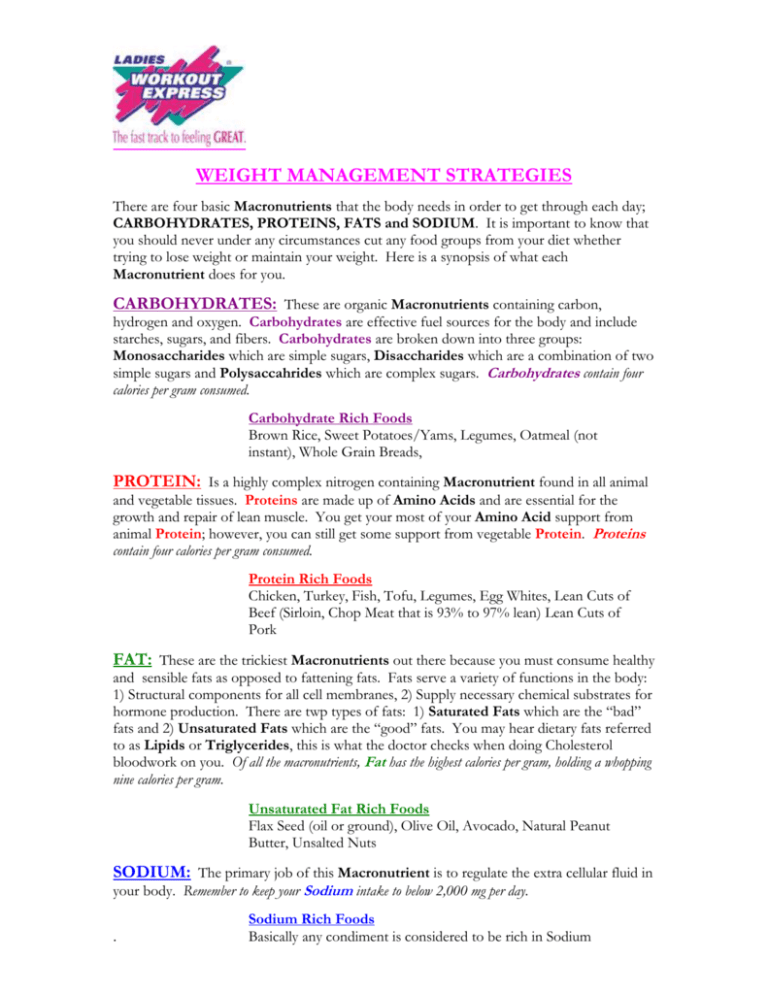
WEIGHT MANAGEMENT STRATEGIES There are four basic Macronutrients that the body needs in order to get through each day; CARBOHYDRATES, PROTEINS, FATS and SODIUM. It is important to know that you should never under any circumstances cut any food groups from your diet whether trying to lose weight or maintain your weight. Here is a synopsis of what each Macronutrient does for you. CARBOHYDRATES: These are organic Macronutrients containing carbon, hydrogen and oxygen. Carbohydrates are effective fuel sources for the body and include starches, sugars, and fibers. Carbohydrates are broken down into three groups: Monosaccharides which are simple sugars, Disaccharides which are a combination of two simple sugars and Polysaccahrides which are complex sugars. Carbohydrates contain four calories per gram consumed. Carbohydrate Rich Foods Brown Rice, Sweet Potatoes/Yams, Legumes, Oatmeal (not instant), Whole Grain Breads, PROTEIN: Is a highly complex nitrogen containing Macronutrient found in all animal and vegetable tissues. Proteins are made up of Amino Acids and are essential for the growth and repair of lean muscle. You get your most of your Amino Acid support from animal Protein; however, you can still get some support from vegetable Protein. Proteins contain four calories per gram consumed. Protein Rich Foods Chicken, Turkey, Fish, Tofu, Legumes, Egg Whites, Lean Cuts of Beef (Sirloin, Chop Meat that is 93% to 97% lean) Lean Cuts of Pork FAT: These are the trickiest Macronutrients out there because you must consume healthy and sensible fats as opposed to fattening fats. Fats serve a variety of functions in the body: 1) Structural components for all cell membranes, 2) Supply necessary chemical substrates for hormone production. There are twp types of fats: 1) Saturated Fats which are the “bad” fats and 2) Unsaturated Fats which are the “good” fats. You may hear dietary fats referred to as Lipids or Triglycerides, this is what the doctor checks when doing Cholesterol bloodwork on you. Of all the macronutrients, Fat has the highest calories per gram, holding a whopping nine calories per gram. Unsaturated Fat Rich Foods Flax Seed (oil or ground), Olive Oil, Avocado, Natural Peanut Butter, Unsalted Nuts SODIUM: The primary job of this Macronutrient is to regulate the extra cellular fluid in your body. Remember to keep your Sodium intake to below 2,000 mg per day. . Sodium Rich Foods Basically any condiment is considered to be rich in Sodium CARBOHYDRATE SOURCES Fruit/Fruit Juices Apple, Apple Juice, Apricots Banana, Cantaloupe, Cherries Grapefruit, Grapefruit Juice, Grapes Kiwi, Mango, Nectarine Orange, Orange Juice, Peach Pear, Pineapple, Pineapple Juice Plums, Raisins, Strawberries, Watermelon Breads Any bread that contains WHOLE WHEAT as it’s main or first ingredient. Cereals/Grains Cream of Wheat, Grape Nuts, Nutri-Grain Oatemal, Puffed or Shredded Wheat Pasta/Potatoes/Rice Whole Grain Pasta Baked, Broiled or Mashed Sweet Potatoes Brown or Grain Rice Pasta/Potatoes/Rice Asparagus, Beets, Broccoli Brussel Sprouts, Cabbage, Cauliflower Celery, Cucumber, Eggplant Green Beans, Lentils, Lettuce Mushrooms, Onions, Peas Peppers, Spinach, Tomtatoes PROTEIN SOURCES Meat and Eggs Beef, Flank Steak Lean Ground Beef 931% - 97% Lean Beef Top, Round, Eye Chicken Breast, Cottage Cheese Egg Substitute or Whites Protein Powder, Turkey Breast, Pork PROTEIN SOURCES Fish Clams, Crab, Haddcok, Halibut Lobster, Salmon, Scallops Sea Bass, Shrimp, Snapper Swordfish, Trout, Tuna Steak, Tuna in Water, Whitefish FAT SOURCES Nuts/Butters Almond Butter, Cashews, Cashew Butter Macadamia Nuts, Peanuts, Peanut Butter, Walnuts Oils Almond Oil, Canola Oil, Corn Oil Olive Oil, Peanut Oil, Sesame Oil Other Avocado, Guacomole, Olives SODIUM SOURCES All condiments and seasonings TIPS FOR HEALTHY EATING Healthful Proteins Protein is crucial for any eating plan. It ensures that you are losing fat and not muscle. Good Carbohydrates Some fad diets will make you skip carbohydrates completely….this is NOT HEALTHY. What is healthy is to keep within the Glycemic Index. Foods that are low on the Gylcemic Index are the most productive Carbohydrates because they keep your blood sugar stable. Spikes in blood sugar are what cause you to feel hungry when you really aren’t. Healthful Fats Moderation Skimming some of the Fat from your diet can help to reduce the calories you absorb from fat. People who include some Fat -rich foods in their weight loss diets felt more satisfied and were better able to stick to a healthy eating pattern. Fat that are encouraged are the ones you get from nuts, olive oil, flaxseeds, and avocados, these Fat satisfy without clogging arteries. Bulk and Roughage Foods that have a high water content and plenty of fiber create a feeling of fullness and satisfaction without excess calories. All unrefined plant foods are fiber rich. Get Plenty of Calcium Diets low in Calcium can create hunger. Getting enough Calcium from foods is important for your bones and teeth. Don’t Go Too Long Without Eating Always work it so that you can eat around every 3 hours. Keep Healthy Foods On Hand Always keep healthful foods in stock in your refrigerator, freezer and pantries, this will ward off unhealthy binges. YOUR FAVORITES MADE HEALTHY INSTEAD OF CHOOSE Regular Pasta Whole Wheat Pasta White Rice Brown Rice White Bread Whole Wheat/Grain Bread Regular Ground Beef 93%/97% Lean Ground Beef Cheese Low Fat Cheese Mayonnaise Low Fat Mayonnaise French Fries Sweet Potato Fries Pancakes Whole Wheat Pancakes Ice Cream Yogurt Reduced Fat or Frozen Regular Candy Bar Patty 3 Muskateer or Peppermint Fried Chicken Oven Baked Chicken Potato Chips Baked Chips or Pretzels Salad Dressing Vinegar Light Dressing or Oil and These are just a few tips that you can incorporate into your daily meal planning. Remember you can always make healthful substitutions for any and all meals! Have a Healthy and Happy Lifestyle!!
